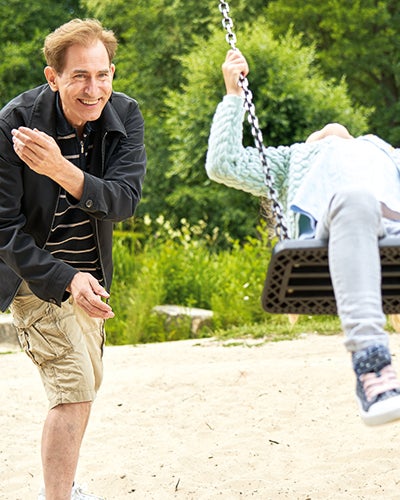Train your coordinative and motor skills
This form of exercise is strongly encouraged in both the acute phase and the rehabilitation phase. Big advantages of this training are that the odds of injuring yourself are very low and that these exercises are easy to do. Training your muscle coordination in a focused way can help strengthen your balance, make coordinated actions easier to do and can replace lost strength.
Please, always coordinate your training program with your health care team before starting on your own!
At first, warm up and do all the exercises slowly. When you get tired, stop. To improve efficiency, vary your training program.
Sensorimotor training
Focused training of the interaction of your senses (seeing, smelling, tasting, feeling, hearing) is called sensorimotor training. This type of training is very beneficial for overcoming peripheral neuropathy, a possible side effect of chemotherapy . Neuropathy often affects the sense of touch in particular. Recovery from these sensory disorders depends on your specific treatment process and chemotherapy. You can train your sensitivity with simple, everyday activities.
Here are some suggestions:
- Massage your feet with a prickly ball while watching TV.
- Use modelling clay to strengthen your hand muscles and train your fine motor skills. Knead and shape it into objects, such as numbers or letters.
- Strengthen your foot muscles and fine motor skills by grabbing and tearing newspaper with your toes.
- Stimulate your blood circulation when taking baths or showers by changing the temperature from hot to cold
- Try warm or cold footbaths with rollers or vibrating massage functions.
- Fill bowls with different ingredients, e.g., dried legumes like peas, beans and lentils, but also pasta, rice, sand, stones, marbles, toys, etc. and focus on the weight, shape or surface texture (coarse, smooth) to train your haptic perception, tactile sense and overall perception.
- Walk barefoot on different surfaces (grass, sand, bark, etc.) or on barefoot paths.
Motor function training
Motor function is the process of controlling motion. There are different techniques and basic skills: endurance, strength, speed, flexibility and coordination. Motor function and sensory training are closely connected, as all motions are continuously controlled by information from the senses. The following exercises are intended to support the interaction of your nerves and muscles to reduce constraints and improve your quality of life. These exercises focus on your balance. In addition, they counteract any existing muscle weakness.
Sample exercises:
Tiptoeing
Stand on your tiptoes, heels lifted as far as possible from the floor, hold briefly at the highest point and lower until your heels touch the floor.
The more you train the better you get. Adjust the repetitions and do as many as you can. Take a short break (1- 2 minutes) and then you can start the second set.
Brushing teeth differently
Challenge your brain by trying to brush your teeth with the "other" hand. Let it become a new routine.
3-point leg swings
Stand on one leg. Move the other leg in a semicircle by tapping your foot once on the floor in front of you, then once at your side and once behind you. Change legs. Alternatively: tap two times or do it counterclockwise.
Chair stands
Sit down on a chair and stand up without using your hands, sit down again. Repeat.
Step climbing exercise
Look for a stairway and hold on to the railing. Put your foot on the farthest step possible. Climb up and put the other foot back down in the starting position. After your set of repetitions, do the same with the other leg.
Balancing
While doing this exercise, make sure you can grab onto something at any time to hold yourself up and to position your training equipment solidly so they don’t skid. This exercise is meant to be performed without shoes.
This is your standard position: Stand up straight and distribute your weight evenly on both feet, bend your knees slightly and let your arms hang down by your sides or use them to balance. Look straight ahead; focusing on a point in front of you may help you keep your balance.
You should increase the level of difficulty from easy to difficult, from stable to unstable, from single to multiple tasks:
- Start by standing with both legs on a solid surface.
- Now reduce your standing area by decreasing its width, e.g., place one foot in front of the other.
- Then reduce your standing area further by also reducing its length (stand on one leg).
The aim is to stand as still as possible without holding onto anything. Choose the level of difficulty for the exercise so that you are just able to stand without holding on for 20 seconds or without putting the "free" foot down while standing on one leg.
It is basically recommended to start the exercises under the instruction of a physical therapist. Later on, you can do them on your own.
You can increase the difficulty further by turning your head, tilting your head back or even closing your eyes instead of looking straight ahead. You can also make your standing surface unstable (e.g., with a balance disc or board) and add additional motor tasks (e.g., circle a ball around your hip or make figure eight shapes with your free leg) or cognitive tasks (e.g., counting backwards).



